It will now be shown that it is possible to implement something very similar to the iterators described in the papers I wrote on Full Metal Jacket.
Macros permit behaviour which cannot be achieved
even with higher-order functions. For example, instead of sending data
once each time it receives data, the emit macro defined below
continues to send data until its inputs satisfy a condition,
the collect macro refrains from sending data until
its inputs satisfy a condition, and the filter macro only sends
data when its inputs satisfy a condition. Together, these can act
as the components of a pipeline.
Inline Macros
Until now, iteration has been done using a single
pair of start+ and repeat+ nodes, with values
being updated in lockstep. It is possible in some cases to have a looser
arrangement, by means of a pair of start+ and
repeat+ nodes updating two values independently in separate
loops. This might cause one loop to run faster than the other, resulting
in either a build-up of values in input queues in the other loop or,
if it runs slower, vertices on the other loop waiting for input,
but it does offer more flexibility.
iterReverse
can be redrawn with two separate loops as follows:

The decons node in the original implementation
of iterReverse has been split up into car and
cdr.
Rearranging gives us:

I have surrounded each loop. The upper loop is the
master or emitter loop, and the lower loop is the slave or
collector loop, with the car vertex belonging to
neither loop.
A similar decoupling can be done to
iterFac:

and then it, too, can be rearranged:

The emitter and collector loops cannot be made into functions, as they typically emit values several times each time they receive arguments, or collect values several times before producing outputs, and, as we shall see, they do not always emit or receive values on all of their arguments. However, they can be made into macros.
Inlining is the simplest kind of macro. When an inlined macro is used, the subgraph of vertices and edges it contains is expanded in place of the vertex containing it, so it is executed without the overhead of calling it, or returning from it.
The emitter and collector macros required for the reverse
function are:


Using the above inline macros, the reverse function can now be drawn
as follows:
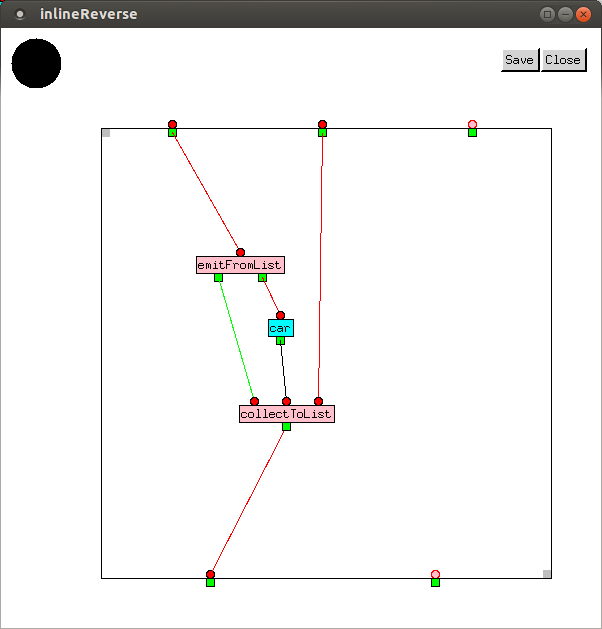
If the inputs to inlineReverse are
(a b c) and (d e), the iterations are:
| Inputs | Emitter | Outputs | Inputs | Collector | Outputs |
(a b c) | emitFromList | NIL |
NILa(d e) | collectToList | ∅ |
∅ | emitFromList | NIL |
NIL | collectToList | ∅ |
∅ | emitFromList | NIL |
NIL | collectToList | ∅ |
∅ | emitFromList | T |
T | collectToList | (c b a d e) |
and
inlineReverse finally outputs (c b a d e).
(∅ signifies no input/output.)
Similarly, the factorial function can be redrawn
using inlining as follows:



With 4 as input, execution of
inlineFac proceeds as follows:
| Inputs | Emitter | Outputs | Inputs | Collector | Outputs |
4 | countDownToOne | NIL |
NIL41 | collectToProduct | ∅ |
4 | valve+ | 1 |
|||
∅ | countDownToOne | NIL |
NIL | collectToProduct | ∅ |
∅ | countDownToOne | NIL |
NIL | collectToProduct | ∅ |
∅ | countDownToOne | NIL |
NIL | collectToProduct | ∅ |
∅ | countDownToOne | T |
T | collectToProduct | 24 |
Emitters and collectors can be combined in different
ways. For example, to calculate the product of the numbers in a List,
we could connect the emitter used in iterReverse to the
collector used in iterFac. Here is the code for
inlineIota, an inline version of the iota function:
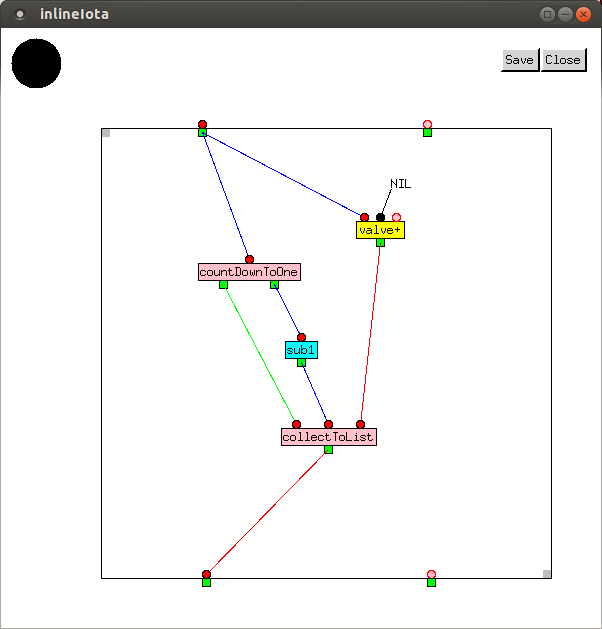
Because the contents of macros contain edges which are not connected at both ends, they can only be used inside enclosures, so they cannot be used in the sandbox.
Substitution Macros
The emitters for iterFac
and iterReverse are structurally identical, and so are their
collectors, so instead of using separate inline macros for each, we could
use the same macros, emit and collect, for both,
by supplying them with different parameter values.


The %1 vertex takes a function as its first
argument. Subsequent arguments are arguments of the function. If
the function is a primitive (i.e. a function written in Emblem),
the %1 vertex is then replaced by a new vertex containing
the code for the primitive. If it is an enclosure, the subgraph contained
in the enclosure is expanded in place of the %1 vertex.
The reverse, factorial, and iota functions can now
be redrawn as follows:
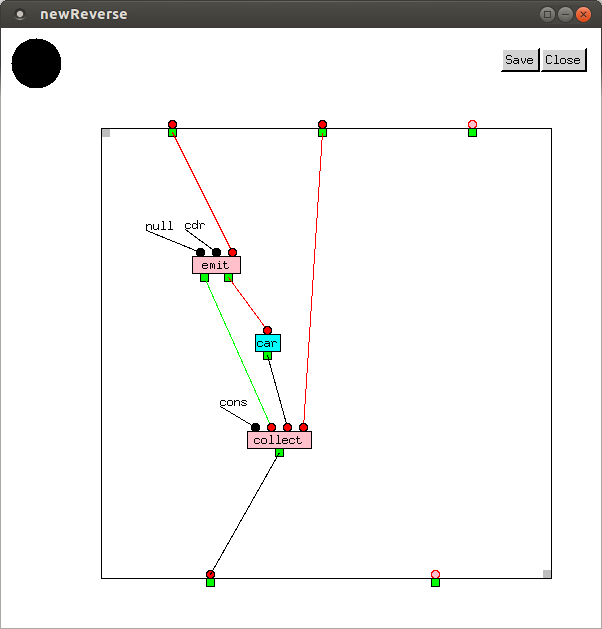
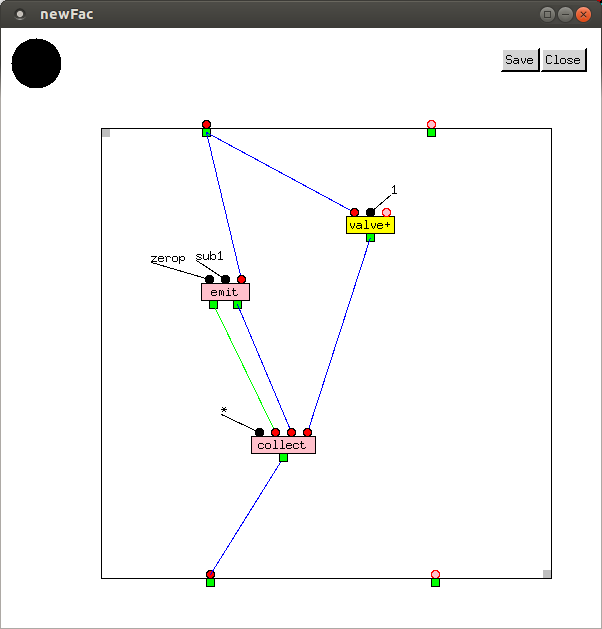
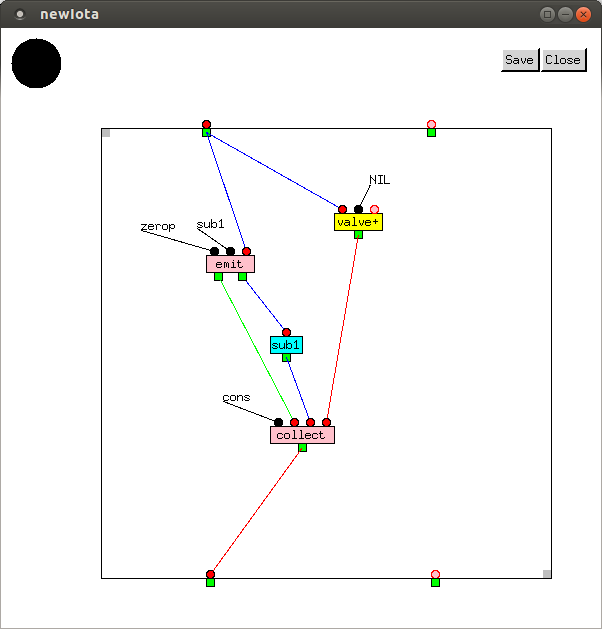
In newReverse and newIota,
values are transformed after leaving emit before entering
collect. Often, it is also necessary to filter values
out. This can be done using the filter macro, which
retains values only if the function it is supplied returns T:

Rewrite Macros
These will contain code in Full Metal Jacket, which generates a graph which replaces them, and are the most general kind of macro. They are not implemented yet.
© Copyright Donald Fisk 2015, 2016